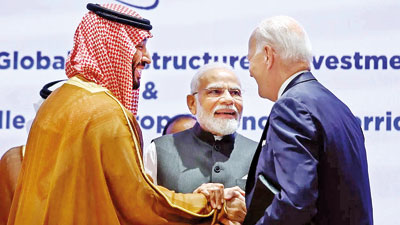Sunday Times 2
Colombo Port must seize opportunities in new corridor
View(s):By Ayesh Indranath Ranawaka
In the ever-evolving landscape of global trade and geopolitics, Sri Lanka finds itself at a crossroads with a unique opportunity—the India-Middle East-Europe Corridor. This proposed trade route could reshape the nation’s destiny and elevate its standing in the international arena. Let’s delve into what this corridor entails and why it holds immense importance for Sri Lanka.
Sri Lanka, strategically located in the middle Indian Ocean, has always been a vital link in global trade routes. However, traditional routes have their limitations. India, for instance, cannot directly access Europe due to the geographical barriers controlled by China and Pakistan to the north. Meanwhile, Afghanistan’s turmoil has made it a challenging prospect for it to connect to the Indian Ocean through Pakistani ports. Since the end of World War II, the world has increasingly shown an aversion to unilateral invasions, making diplomacy and peaceful solutions imperative, until Putin’s invasion of Ukraine. Therefore, the only way that India can connect this corridor is from a port located on the west coast, which has no accommodation for mega ships. (Mundra belongs to the Adani Group, probably.)

Leaders of India, the US and Saudia Arabia taking part in a ceremony early this month to annouce the new economic corridor. AFP
The India-Middle East-Europe Corridor (IMEC) emerges as a solution to these complexities. It represents a paradigm shift in global trade dynamics, providing an alternative route that bypasses these geopolitical obstacles. Unlike some initiatives that have raised concerns about confrontations with China or Russia, the corridor aims to foster connectivity, economic growth, and stability.
The strategic implications of this corridor extend beyond trade. With India’s increasing focus on maritime security and the Indian Ocean region, discussions about French submarines passing through the proposed Sethu Samudram Canal and military strategy have gained prominence. The corridor could play a role in facilitating naval deployments and enhancing India’s maritime capabilities.
One of the primary challenges faced by this ambitious project is the physical task of connecting India to Sri Lanka and the proposed Sethu Samudram Canal. Due to the complex underwater geography and hydrodynamics of the Mannar Basin, constructing a bridge or canal is no small task. However, the potential rewards far outweigh the difficulties. Creating a link would not only provide a shortcut for trade but also strengthen ties between the two nations. The heart of this corridor MUST be Colombo, Sri Lanka’s busiest port. Colombo is well-positioned to become a major hub for the flow of goods, capital, and information along this route. Colombo’s port is poised to see an exponential increase in activity. This transformation would not only boost Sri Lanka’s economy but also elevate its status as a key player in regional and global affairs.
Sri Lanka needs to improve its infrastructure in Colombo Port. Otherwise, the 20-metre-draft Adani’s terminal will grab the opportunity. Sri Lanka Lanka must seek new strategies and connect to the corridor through the proposed India-Sri Lanka Bridge. This will change our economy for the better. The increased traffic from the IMEC can lead to congestion at Colombo Port, causing delays in cargo handling and shipping schedules. This congestion can be challenging to manage and may require continuous investment in infrastructure and operational efficiency. The higher volume of shipping traffic can have adverse environmental effects. The government need to implement measures to mitigate these environmental concerns.
While Colombo Port benefits from its strategic location, it also faces competition from other ports in the region, such as those in India and the UAE. These ports are actively seeking to attract more shipping traffic and may offer competitive advantages that could divert some trade away from Colombo. The corridor’s significance and the competition among various countries to control and influence it can lead to geopolitical tensions that may indirectly affect Colombo Port’s operations and trade volumes.
The IMEC presents an exciting opportunity for Sri Lanka, promising economic growth, enhanced connectivity, and a pivotal role in global trade. While challenges remain, the potential benefits are too significant to be overlooked. Sri Lanka’s strategic location in the Indian Ocean, combined with its participation in this corridor, could reshape the nation’s future and contribute to a more interconnected and peaceful world. As the world increasingly shuns war and embraces cooperation, the corridor offers a beacon of hope for nations seeking progress through unity.
This is my analysis, and it is not aligned to the proposed corridor from Mumbai to Piraeus in Greece, but far beyond.
(The writer is the Director
/CEO of the Institute of Ocean Resources Analysis)

